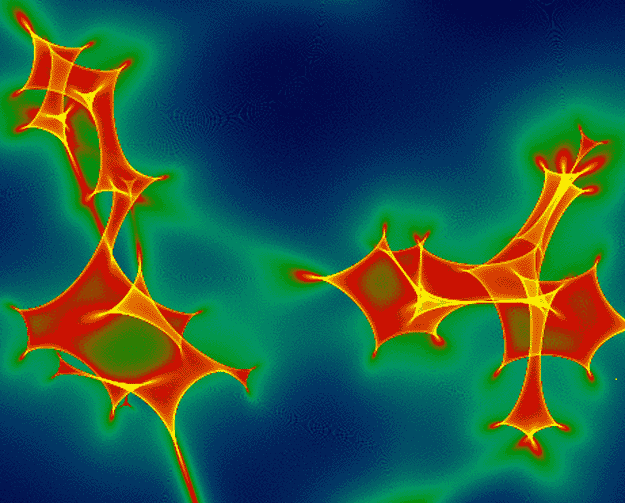Credit & Copyright: Joachim Wambsganss
(Ap. Inst. Potsdam)
Explanation:
A virtual sky map like this would be of interest
to astronomers studying gravitational microlensing.
In microlensing, the gravity of stars near the line of sight
can act to magnify the light of background objects such as
distant stars, or
quasars.
Nowhere is this magnification greater
than near a gravitational lensing
caustic.
In the
above computer simulated map,
caustics are discernible as the sharp bright curved lines.
When a background
quasar
moves across a microlensing caustic,
it can appear
dramatically brighter.
Many astronomers thought
microlensing events practically
immeasurable even twenty years ago,
but within the past five years now
hundreds have been found.
Precise measurements of microlensing are now
providing unique information about the
composition and distribution of matter in
galaxies
and the
universe.
Some astronomers now predict that future
microlensing searches might even
isolate planets orbiting distant stars.
1999 2000 2001 2002 2003 2004 2005 2006 2007 2008 2009 2010 2011 2012 2013 2014 2015 2016 2017 2018 2019 2020 2021 2022 2023 2024 2025 |
Январь Февраль Март Апрель Май Июнь Июль Август Сентябрь Октябрь Ноябрь Декабрь |
NASA Web Site Statements, Warnings, and Disclaimers
NASA Official: Jay Norris. Specific rights apply.
A service of: LHEA at NASA / GSFC
& Michigan Tech. U.
|
Публикации с ключевыми словами:
microlensing - Микролинзирование - квазары
Публикации со словами: microlensing - Микролинзирование - квазары | |
См. также:
Все публикации на ту же тему >> | |
